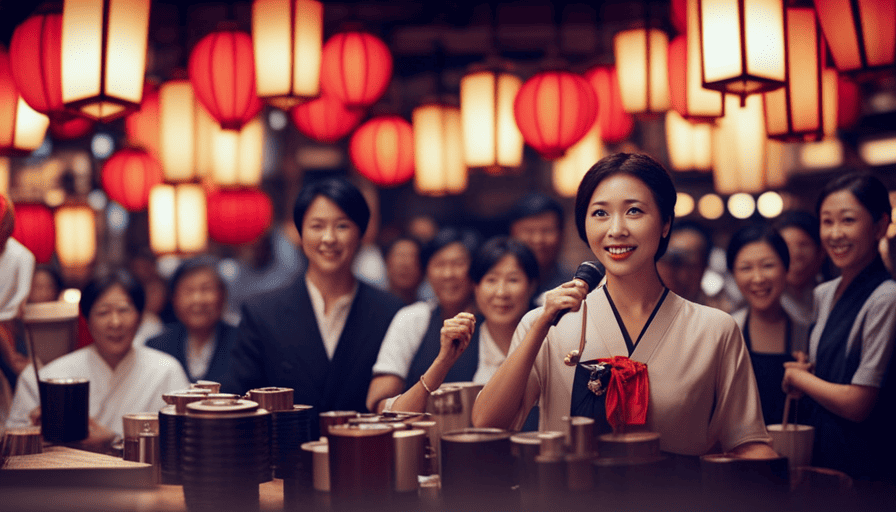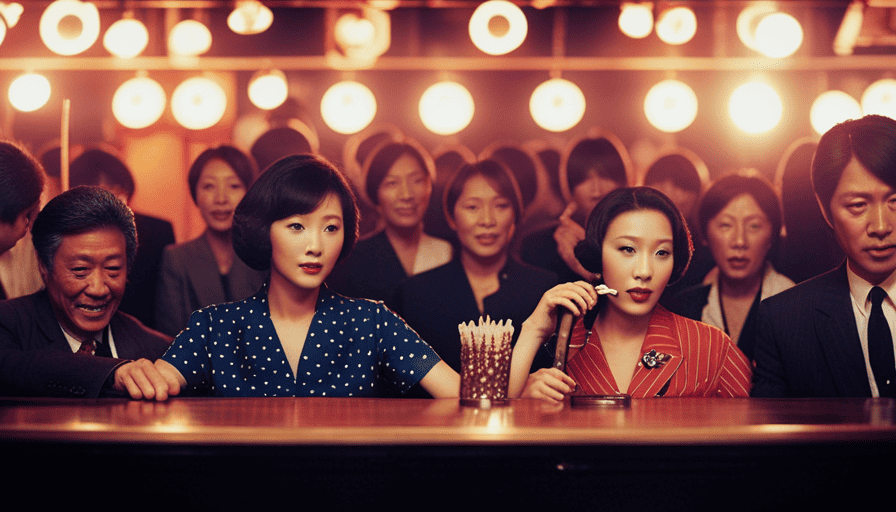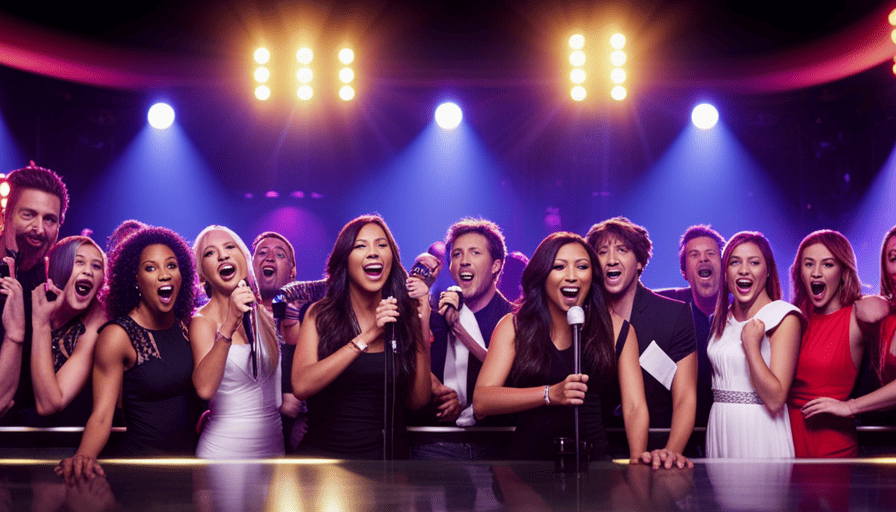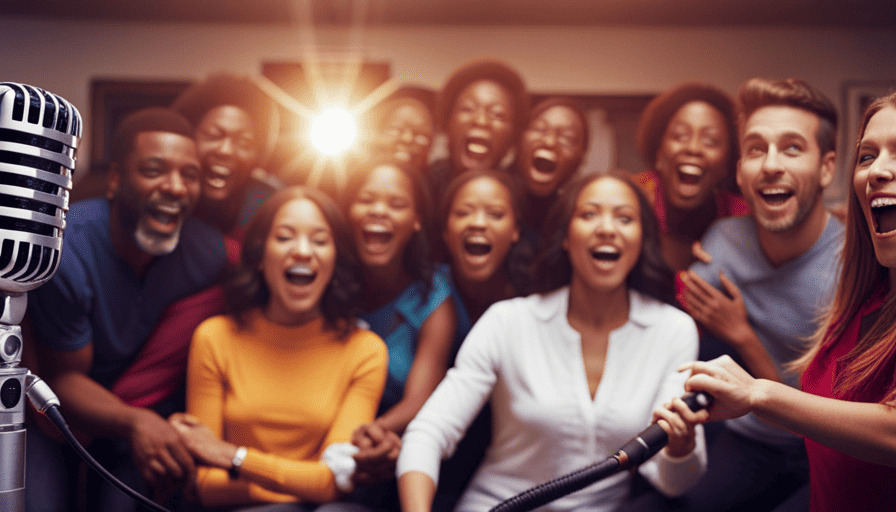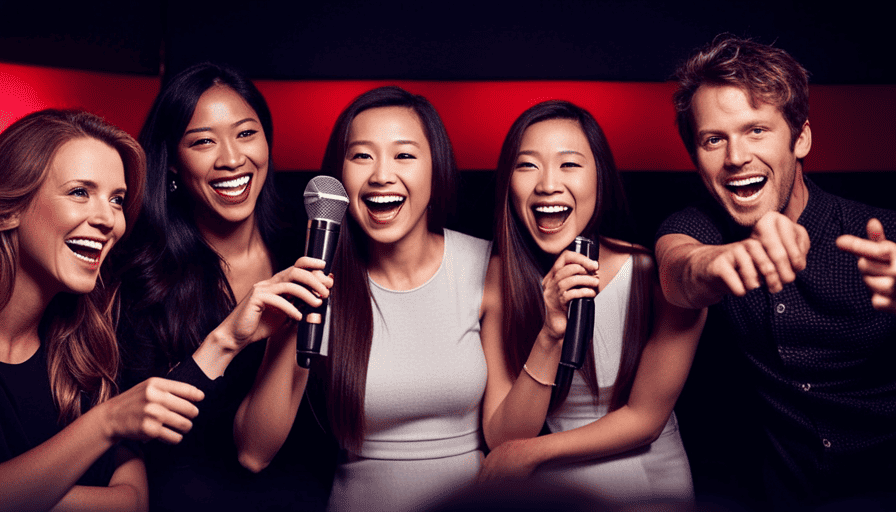Have you ever been singing your favorite song at a karaoke bar, surrounded by friends and strangers? It’s a liberating experience that allows us to release our inhibitions and express ourselves through music. But have you ever stopped to think about the history of this beloved pastime? Prepare to be amazed.
Picture this: it’s 1971 in Kobe, Japan. A tired businessman named Daisuke Inoue has just completed a long day of work when he receives an unusual request from his clients. They want him to create a machine that can play instrumental tracks so they can sing along at their parties. Intrigued by the idea, Inoue sets to work and invents what we now know as karaoke.
Yes, you heard that right. Karaoke was born out of a desire for Japanese businessmen to unwind after a hard day’s work. Little did they know that their invention would go on to captivate people all over the world.
In this article, we will delve into the fascinating history of karaoke, exploring its cultural significance and its evolution over time. So grab your microphone and get ready for a journey through the origins of karaoke!
Key Takeaways
- Karaoke was invented in Kobe, Japan in 1971 by Daisuke Inoue.
- It was created as a form of entertainment for Japanese businessmen to relax after work.
- Karaoke quickly gained popularity in Japan and became a cultural phenomenon.
- Karaoke machines spread throughout Japan and then to other parts of Asia, revolutionizing the music industry and influencing popular culture.
The Origins of Karaoke
The origins of karaoke can be traced back to Japan, where it was first developed in the 1970s as a form of entertainment that allowed people to sing along to pre-recorded music tracks. The birthplace discovery of karaoke is often credited to a Japanese musician named Daisuke Inoue. Inoue invented the first karaoke machine in 1971, which he called the ‘8 Juke.’ This groundbreaking invention changed the way people enjoyed music by allowing them to become part of the performance.
Karaoke quickly gained popularity in Japan and eventually spread worldwide, becoming a cultural phenomenon. It provided an opportunity for people to showcase their singing talents and share their love for music with others. It also became a social activity that brought friends and family together, creating lasting memories.
The cultural impact of karaoke cannot be overstated. It not only revolutionized the music industry but also influenced popular culture. Karaoke bars and competitions became ubiquitous in Japan and later around the world. Today, you can find karaoke machines at home, in bars, and even on cruise ships.
Transitioning into the subsequent section about ‘the birthplace of karaoke,’ it’s fascinating to explore how this Japanese entertainment trend made its way beyond its homeland’s borders.
The Birthplace of Karaoke
Originating in Japan, karaoke quickly became a worldwide phenomenon, captivating audiences with its unique blend of music and entertainment. The birthplace of this beloved pastime can be traced back to the city of Kobe in Japan.
It was here that a musician and inventor named Daisuke Inoue first came up with the idea for karaoke in the early 1970s. Inoue noticed that people wanted to sing along to their favorite songs but didn’t have access to live bands or musicians. This inspired him to create a machine that could play instrumental tracks while allowing individuals to sing along.
In 1971, Inoue built his first prototype called the ‘8 Juke’ which allowed customers at his bar to sing along to popular songs using a microphone. The concept quickly gained popularity and spread throughout Japan, leading Inoue to patent his invention in 1975. From there, karaoke machines started popping up in bars and clubs across the country.
The invention of karaoke revolutionized the way people experienced music and entertainment. It provided an opportunity for anyone, regardless of their musical talent, to step into the spotlight and perform their favorite songs. This newfound accessibility and enjoyment paved the way for karaoke’s global success.
Transitioning into the subsequent section about ‘the early history of karaoke’, we will explore how it gained popularity outside of Japan and made its way into other parts of the world without losing its essence as a source of joyous entertainment.
The Early History of Karaoke
Imagine stepping into a vibrant bar in the early 1970s, surrounded by music lovers belting out their favorite tunes and experiencing the birth of a worldwide phenomenon. This was the scene that unfolded in Kobe, Japan, where the early history of karaoke began.
Early karaoke machines played an instrumental role in popularizing this form of entertainment. Invented by Japanese musician Daisuke Inoue in 1971, these machines allowed people to sing along to prerecorded tracks. As they became more accessible, karaoke quickly spread across Japan and then made its way to other parts of Asia.
Karaoke competitions also played a significant role in fostering the growth of this cultural sensation. These events provided aspiring singers with a platform to showcase their talent and gain recognition. Karaoke contests not only fueled enthusiasm for singing but also contributed to the development of innovative technologies that improved sound quality and added visual effects.
To truly capture the essence of this transformative period, imagine:
- The electric atmosphere as passionate performers poured their hearts out on stage.
- The contagious energy that filled the room as spectators cheered for their favorite contestants.
- The nerves and excitement felt by individuals taking part in these groundbreaking competitions.
- The sense of community that emerged as people came together through their shared love for music.
As we delve deeper into exploring the cultural significance of karaoke, it becomes evident how this phenomenon has shaped communities around the world.
The Cultural Significance of Karaoke
With its ability to bring people together and foster a sense of shared passion for music, karaoke has become an integral part of cultural expression worldwide. The cultural impact of karaoke music cannot be overstated. It has transcended borders and language barriers, allowing individuals from different backgrounds to come together and enjoy the universal language of music.
Karaoke nights have become popular in bars, clubs, and even private gatherings. People gather around the microphone, take turns singing their favorite songs, and cheer each other on. This communal experience creates a sense of camaraderie and belonging, making karaoke a powerful tool for building connections among individuals.
Furthermore, karaoke has played a significant role in empowering individuals to express themselves creatively. It provides an opportunity for people with varying levels of musical talent to showcase their skills or simply have fun without judgment. This inclusive nature of karaoke encourages self-confidence and fosters personal growth.
As technology continues to evolve, so does the world of karaoke. The advent of portable microphones and digital platforms has made it easier than ever for people to indulge in their love for singing anytime and anywhere. This evolution in karaoke technology has further enhanced its accessibility and popularity among music enthusiasts.
Transitioning into the subsequent section about the evolution of karaoke technology, we can explore how these advancements have revolutionized the way people engage with this beloved form of entertainment.
The Evolution of Karaoke Technology
The incredible journey of karaoke technology has transported music lovers into a world where their voices can soar, melodies can be perfected, and the stage is always within reach. The evolution of karaoke technology has revolutionized the way we experience and enjoy this popular form of entertainment.
Here are three ways in which karaoke technology has evolved:
-
Wireless microphones: Gone are the days when performers were confined to a stationary microphone. With wireless microphones, singers can now freely move around the stage, engaging with their audience and adding an extra element of excitement to their performance.
-
Digital song libraries: In the past, karaoke enthusiasts had limited options when it came to song choices. However, with the advent of digital song libraries, singers now have access to an extensive collection of songs from various genres and eras. This allows them to explore new musical styles and cater to diverse audiences.
-
Interactive displays: Traditional karaoke machines featured basic text displays that showed lyrics while a backing track played in the background. Nowadays, interactive displays provide synchronized lyrics along with visually appealing graphics or videos that enhance the overall karaoke experience.
The evolution of karaoke technology has undoubtedly contributed to its popularity in popular culture today. From trendy karaoke bars to televised singing competitions, this modernized form of entertainment continues to captivate audiences worldwide.
As we delve into ‘the global spread of karaoke,’ let’s explore how different cultures have embraced this phenomenon and made it their own.
The Global Spread of Karaoke
Karaoke has become a ubiquitous form of entertainment, transcending cultural boundaries and captivating audiences worldwide. The global karaoke trend has exploded in recent years, with karaoke bars and clubs popping up in cities all over the world.
What was once seen as a Japanese invention has now become a beloved pastime for people from all walks of life. One of the fascinating aspects of karaoke’s global spread is how it adapts to different cultures. In Japan, where karaoke originated, it’s more than just singing; it’s an opportunity for people to bond with their colleagues or friends after work.
In South Korea, karaoke rooms called noraebangs are popular social spaces where groups can rent out private rooms to sing and have fun together. In the United States, karaoke has evolved into a competitive sport, with televised shows like American Idol and The Voice showcasing talented singers.
As you transition into the subsequent section about famous karaoke moments in history, it’s clear that this form of entertainment has made its mark on the world stage. From drunken renditions at office parties to unforgettable performances by celebrities, there are countless memorable moments that highlight the universal appeal of karaoke.
Famous Karaoke Moments in History
You won’t believe how many celebrities have belted out their favorite tunes in karaoke bars, with some sources estimating that over 60% of Hollywood stars have had a karaoke moment at least once in their lives. Karaoke has become a popular pastime for the rich and famous, allowing them to let loose and showcase their singing skills without the pressure of performing on stage.
Here are three famous karaoke moments in history:
-
Tom Cruise: Known for his intense roles in action movies, Tom Cruise surprised everyone when he took the mic at a karaoke bar and sang ‘Pour Some Sugar on Me’ by Def Leppard. His energetic performance showcased his hidden talent as an entertainer.
-
Beyoncé: Even music royalty like Beyoncé enjoys a fun night out at a karaoke bar. She wowed the crowd with her rendition of Whitney Houston’s ‘I Will Always Love You,’ hitting every note flawlessly and proving why she is one of the greatest singers of our time.
-
Barack Obama: Our former president showed off his vocal skills during a fundraising event when he joined singer Al Green on stage for an impromptu duet of ‘Let’s Stay Together.’ Obama’s smooth voice charmed the audience and solidified his status as not only a great leader but also a talented performer.
These famous karaoke moments highlight how even the biggest stars enjoy taking part in this beloved activity. Moving forward into the next section about ‘karaoke in popular culture,’ we will explore its impact on music and entertainment.
Karaoke in Popular Culture
With its infectious beats and lively atmosphere, karaoke has become a staple in bars, clubs, and even living rooms across the globe. Its presence is not limited to these venues alone, as karaoke has also made its mark in popular culture through movies and TV shows.
Many films have featured memorable karaoke scenes that have become iconic moments in cinematic history. From ‘Lost in Translation’ where Bill Murray’s character belts out a soulful rendition of ‘More Than This’ to ‘Pitch Perfect’ where the Barden Bellas harmonize their way to victory, karaoke has provided audiences with both comedic and emotional experiences.
TV shows have also embraced the popularity of karaoke by incorporating it into their storylines. In the hit show ‘How I Met Your Mother,’ characters often gather at MacLaren’s Pub for their weekly karaoke night, showcasing hilarious performances that add depth to their relationships. Similarly, on ‘The Office,’ employees frequently partake in office-wide karaoke sessions that create moments of camaraderie and bonding.
These representations of karaoke in movies and TV shows highlight its universal appeal as a form of entertainment and social activity. It brings people together, encourages self-expression, and creates lasting memories. As we delve further into the topic of ‘karaoke as a social activity,’ let’s explore how this phenomenon has impacted communities around the world without missing a beat.
Karaoke as a Social Activity
Now that we’ve explored the impact of karaoke in popular culture, let’s dive into its role as a social activity. Karaoke has become a beloved pastime for many people around the world, with karaoke clubs popping up in cities everywhere.
These establishments provide a space where friends, family, and even strangers can gather to sing their hearts out. Karaoke clubs offer a unique experience, creating an atmosphere filled with laughter, camaraderie, and shared musical enthusiasm. It’s not just about showcasing vocal talents; it’s about having fun and enjoying the company of others.
In fact, karaoke competitions have gained popularity as well, allowing individuals to compete against one another for the title of the best performer. Within these clubs and competitions, there are two main sub-lists that grab our attention:
-
The joy of singing: Karaoke provides an outlet for self-expression and allows individuals to showcase their favorite songs.
-
Social bonding: Participating in karaoke brings people together and fosters connections through shared experiences.
As we look ahead to the future of karaoke, it’s clear that this social phenomenon will continue to thrive. But what innovations lie on the horizon? Let’s explore how technology may shape the future of this beloved activity in our next section.
The Future of Karaoke
Imagine a future where advanced artificial intelligence technology is integrated into karaoke machines, allowing singers to receive instant feedback and personalized vocal coaching based on their individual singing style and preferences. This could be the future of karaoke, as virtual karaoke experiences become more popular and accessible.
With AI-powered karaoke assistants, singers won’t have to rely solely on their own judgment or the opinions of others. These assistants would analyze vocal patterns, pitch accuracy, and provide real-time guidance to help singers improve their skills.
Not only would AI-assisted karaoke enhance the singing experience for individuals, but it could also revolutionize group karaoke sessions. Imagine being able to choose from a vast library of songs and have an AI assistant select the perfect background music and harmonies based on your voice. Singers could even customize their performances with different vocal effects or styles.
Furthermore, the future of karaoke may include virtual reality (VR) technology, allowing users to immerse themselves in realistic concert-like settings without leaving their homes. They could perform alongside virtual band members or famous artists, making each performance feel like a once-in-a-lifetime opportunity.
The future of karaoke holds exciting possibilities with AI-powered karaoke assistants and virtual reality experiences. These advancements have the potential to transform how we enjoy and engage with this popular social activity by providing personalized feedback, enhancing group sessions, and creating immersive performances.
Frequently Asked Questions
How did karaoke become popular in Japan?
Karaoke became popular in Japan through a combination of factors. In the 1970s, karaoke machines were introduced to bars and clubs, providing an opportunity for people to sing along to instrumental tracks.
The rise of televised karaoke competitions further fueled its popularity.
To this day, karaoke etiquette is highly valued in Japan, with participants expected to wait their turn, respect others’ performances, and follow proper singing manners.
What are some famous karaoke bars in Tokyo?
Some popular karaoke bars in Tokyo include Karaoke-kan, Big Echo, and Shidax. These establishments offer a wide range of song selections, including both Japanese and international hits.
Some popular karaoke songs in Japan are ‘I Will Always Love You’ by Whitney Houston, ‘Bohemian Rhapsody’ by Queen, and ‘Sukiyaki’ by Kyu Sakamoto. These songs have become staples in karaoke culture due to their catchy melodies and emotional lyrics that resonate with people of all ages.
How has karaoke technology evolved over the years?
Over the years, karaoke technology has undergone impressive advancements. One fascinating statistic is that in 1971, the first commercial karaoke machine was invented in Japan.
Since then, karaoke equipment has become more compact and user-friendly, with features like built-in screens and wireless microphones. Additionally, the rise of digital platforms like YouTube and smartphone apps has made karaoke even more popular and accessible worldwide.
These advancements have revolutionized the way people enjoy karaoke today.
What are some unique cultural traditions associated with karaoke in different countries?
Karaoke has evolved into a cultural phenomenon with unique traditions in different countries. Its cultural significance lies in the way it brings people together to celebrate music and showcase their talents.
In Japan, karaoke competitions are taken very seriously, with participants aiming for perfection and judges evaluating their performance.
In South Korea, singing rooms called noraebangs are popular hangout spots where friends gather to sing and have fun.
These traditions reflect the deep love for music and socializing that karaoke inspires worldwide.
Are there any famous karaoke moments in history outside of Japan?
Famous karaoke moments in history outside of Japan have had a significant impact on pop culture.
One notable example is the 1992 film ‘Wayne’s World,’ where characters Wayne and Garth sing along to Queen’s ‘Bohemian Rhapsody’ in their car, popularizing the idea of group karaoke sessions.
Another iconic moment is from the TV show ‘Friends,’ where Ross and Rachel drunkenly sing ‘Endless Love.’
These moments showcase how karaoke has become an integral part of popular entertainment worldwide.
Conclusion
Congratulations! You’ve now traveled through time and explored the fascinating world of karaoke. From its humble beginnings in Japan to its global popularity today, karaoke has become a beloved social activity that brings people together.
It’s incredible to imagine the vibrant lights, the energetic crowd, and the euphoric feeling of singing your heart out on stage. As technology continues to advance, who knows what exciting developments lie ahead for this cherished pastime?
So grab a microphone, gather your friends, and let the magic of karaoke transport you to a world where dreams come true.

